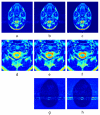POCS-enhanced correction of motion artifacts in parallel MRI
- PMID: 20373413
- PMCID: PMC2852198
- DOI: 10.1002/mrm.22254
POCS-enhanced correction of motion artifacts in parallel MRI
Abstract
A new method for correction of MRI motion artifacts induced by corrupted k-space data, acquired by multiple receiver coils such as phased arrays, is presented. In our approach, a projections onto convex sets (POCS)-based method for reconstruction of sensitivity encoded MRI data (POCSENSE) is employed to identify corrupted k-space samples. After the erroneous data are discarded from the dataset, the artifact-free images are restored from the remaining data using coil sensitivity profiles. The error detection and data restoration are based on informational redundancy of phased-array data and may be applied to full and reduced datasets. An important advantage of the new POCS-based method is that, in addition to multicoil data redundancy, it can use a priori known properties about the imaged object for improved MR image artifact correction. The use of such information was shown to improve significantly k-space error detection and image artifact correction. The method was validated on data corrupted by simulated and real motion such as head motion and pulsatile flow.
Figures





Similar articles
-
POCSENSE: POCS-based reconstruction for sensitivity encoded magnetic resonance imaging.Magn Reson Med. 2004 Dec;52(6):1397-406. doi: 10.1002/mrm.20285. Magn Reson Med. 2004. PMID: 15562485
-
An improved algorithm for rotational motion artifact suppression in MRI.IEEE Trans Med Imaging. 1998 Apr;17(2):310-7. doi: 10.1109/42.700744. IEEE Trans Med Imaging. 1998. PMID: 9688164
-
Fat/water separation in k-space with real-valued estimates and its combination with POCS.Magn Reson Med. 2020 Feb;83(2):653-661. doi: 10.1002/mrm.27949. Epub 2019 Aug 16. Magn Reson Med. 2020. PMID: 31418932
-
Deep learning applications for quantitative and qualitative PET in PET/MR: technical and clinical unmet needs.MAGMA. 2024 Aug;37(4):749-763. doi: 10.1007/s10334-024-01199-y. Epub 2024 Aug 21. MAGMA. 2024. PMID: 39167304 Review.
-
Artifact reduction using parallel imaging methods.Top Magn Reson Imaging. 2004 Aug;15(4):267-75. doi: 10.1097/01.rmr.0000143782.39690.8a. Top Magn Reson Imaging. 2004. PMID: 15548957 Review.
Cited by
-
Improved least squares MR image reconstruction using estimates of k-space data consistency.Magn Reson Med. 2012 Jun;67(6):1600-8. doi: 10.1002/mrm.23144. Epub 2011 Aug 29. Magn Reson Med. 2012. PMID: 22135155 Free PMC article.
-
Self-supervised learning for MRI reconstruction: a review and new perspective.MAGMA. 2025 Jun 26. doi: 10.1007/s10334-025-01274-y. Online ahead of print. MAGMA. 2025. PMID: 40569542 Review.
-
Robust Motion Correction Strategy for Structural MRI in Unsedated Children Demonstrated with Three-dimensional Radial MPnRAGE.Radiology. 2018 Nov;289(2):509-516. doi: 10.1148/radiol.2018180180. Epub 2018 Jul 31. Radiology. 2018. PMID: 30063192 Free PMC article.
-
P-LORAKS: Low-rank modeling of local k-space neighborhoods with parallel imaging data.Magn Reson Med. 2016 Apr;75(4):1499-514. doi: 10.1002/mrm.25717. Epub 2015 May 7. Magn Reson Med. 2016. PMID: 25952136 Free PMC article.
-
Iterative projection onto convex sets for quantitative susceptibility mapping.Magn Reson Med. 2015 Feb;73(2):697-703. doi: 10.1002/mrm.25155. Epub 2014 Mar 6. Magn Reson Med. 2015. PMID: 24604410 Free PMC article.
References
-
- Pruessmann KP, Weiger M, Scheidegger MB, Boesiger P. SENSE: sensitivity encoding for fast MRI. Magn Reson Med. 1999;42:952–962. - PubMed
-
- Sodickson DK, Manning WJ. Simultaneous acquisition of spatial harmonics (SMASH): ultra-fast imaging with radiofrequency coil arrays. Magn Reson Med. 1997;38:591–603. - PubMed
-
- Bydder M, Larkman DJ, Hajnal JV. Generalized SMASH imaging. Magn Reson Med. 2002;47:160–170. - PubMed
-
- Kyriakos WE, Panych LP, Kacher DF, Westin CF, Bao SM, Mulkern RV, Jolesz FA. Sensitivity profiles from an array of coils for encoding and reconstruction in parallel (SPACE RIP) Magn Reson Med. 2000;44:301–308. - PubMed
-
- Griswold MA, Jakob PM, Heidemann RM, Nittka M, Jellus V, Wang J, Kiefer B, Haase A. Generalized autocalibrating partially parallel acquisition (GRAPPA) Magn Reson Med. 2002;47:1202–1210. - PubMed
Publication types
MeSH terms
Grants and funding
LinkOut - more resources
Full Text Sources
Other Literature Sources
Medical

